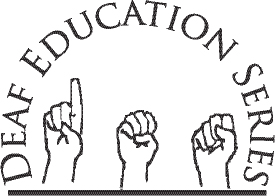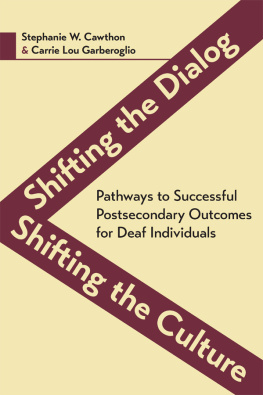Shifting the Dialog,
Shifting the Culture

Donald F. Moores, General Editor
| Volume 1 | Accountability-Based Reform |
| Volume 2 | Partners in Education |
| Volume 3 | Deaf Students and the Qualitative Similarity Hypothesis |
| Volume 4 | Promoting Positive Transition Outcomes |
| Volume 5 | Sign Language, Sustainable Development, and Equal Opportunities |
| Volume 6 | Deaf Epistemologies, Identity, and Learning |
| Volume 7 | Shifting the Dialog, Shifting the Culture |
Shifting
the Dialog,
Shifting
the Culture
Pathways to Successful Postsecondary
Outcomes for Deaf Individuals
Stephanie W. Cawthon
and Carrie Lou Garberoglio
Gallaudet University Press
Washington, D.C.
Gallaudet University Press
Washington, DC 20002
http://gupress.gallaudet.edu
2017 by Gallaudet University
All rights reserved. Published 2017
Printed in the United States of America
Library of Congress Cataloging-in-Publication Data
Names: Cawthon, Stephanie W., editor. | Garberoglio, Carrie Lou, editor.
Title: Shifting the dialog, shifting the culture : pathways to successful postsecondary outcomes for deaf individuals / Stephanie W. Cawthon and Carrie Lou Garberoglio.
Description: Washington, DC : Gallaudet University Press, [2017]
Identifiers: LCCN 2017028146| ISBN 9781944838126 (hard cover : alk. paper) | ISBN 9781944838133 (e-book)
Subjects: LCSH: DeafEducationUnited States. | Postsecondary educationUnited States.
Classification: LCC HV2545 .C39 2017 | DDC 362.4/28dc23
LC record available at https://lccn.loc.gov/2017028146
 This paper meets the requirements of ANSI/NISO Z39.48-1992 (Permanence of Paper).
This paper meets the requirements of ANSI/NISO Z39.48-1992 (Permanence of Paper).
Contents
THIS BOOK would not have been possible without the support of our family, friends, and colleagues.
A note of gratitude goes out to our colleagues Jennifer Coyle and Della Thomas, who were instrumental in helping find relevant case law and digging up key references. We were also fortunate to work with a team of motivated, ambitious, and dedicated graduate students who provided research support: Mark Bond, Yasmine Jassal, Paige Johnson, Rachel Leppo, Sarah Schoffstall, and Erica Wendel. Thank you, also, to Melanie Thornton, who offered careful and thorough suggestions as we made the final edits to this book.
We would also like to thank Adria Rhyne for her creativity and enthusiasm in developing the images used throughout the book.
The development of this manuscript was partially supported by pepnet 2. Pepnet 2 is funded by the Research to Practice Division, Office of Special Education Programs, US Department of Education via Cooperative Agreement #H326D110003 from October 1, 2011 to September 30, 2016.
Key Points
The current picture of how deaf individuals reach their postsecondary goals is incomplete.
Using a systems approach to analysis, this book will help to unpack what we know about the path to postsecondary outcomes for deaf individuals.
Resiliency models help frame our conversation in a way that honors the strengths of deaf individuals as well as acknowledges the barriers that reside within larger educational and social systems.
THIS BOOK provides an in-depth discussion of issues that impact post-secondary outcomes for individuals who are deaf or hard of hearing (deaf individuals), This book is designed for a diverse audience, including professionals who work (or are in training to work) with deaf individuals, as well as federal and state personnel. Without a strong understanding of the current research, policy-makers cannot make informed decisions about the types of programs or services that may best facilitate postsecondary success for deaf individuals. We hope that this book can provide some needed perspective on what supports are already available as well as the types of barriers that reduce access to postsecondary opportunities for deaf individuals.
This chapter lays the groundwork for what we know about post-secondary education and employment for deaf individuals. We introduce key theoretical perspectives and share current national data about post-secondary outcomes, including enrollment in and graduation from training and education programs, entry into the workplace, and independent living. We identify some knowledge and skills gaps many deaf individuals share and describe how this book seeks to fill some of those missing puzzle pieces in understanding what happens in the journey from high school to postsecondary experiences. This book brings together current research, along with stories from the field, to help readers understand important factors that influence postsecondary outcomes for deaf individuals. The stories from the field that are interwoven throughout this book in quotes, but are otherwise unattributed, come from a national needs assessment that our research team conducted in 2012 (Cawthon & the PN2 RES Team). More than 1,500 deaf individuals, their parents, and affiliated professionals participated in surveys, interviews, and focus groups across the nation. The full report of this needs assessment, available online, provides more detail on the data collection methods.
This book views the postsecondary transition process and outcomes for deaf individuals through two lenses. We use a systems theory approach to explore important themes in the transition process, explaining the purpose of this theory as well as ways in which using an ecological approach influences the structure of the book. We also emphasize a resiliency (vs. deficit) perspective, which stresses how deaf individuals persist through the transition process. Both of these perspectives are described in further detail at the end of this chapter.
What Do We Know about Postsecondary Education and Employment Outcomes for Deaf Individuals?
Many researchers in the field start the conversation about deaf education with basic demographics: descriptive statistics that provide an overview of processes and outcomes for deaf individuals. However, from a numbers perspective, large-scale data collection approaches provide different perspectives on what is happening with deaf individuals during transitionthe journey of moving from youth to young adult and the academic, vocational, and personal outcomes resulting from the process.
Deaf individuals tend to do well with high school completion, with recent estimates indicating that the majority, more than 70%, of students successfully received a complete high school diploma or certificate (Newman et al., 2011).
Postsecondary training, known to be essential to higher employment rates and promotion later in life, has increased in recent years, with an estimated 75% of deaf individuals enrolling in some kind of post-high school education or training (Newman et al., 2011).
Postsecondary degree completion is a critical step in successful transition; without credentials, it can be challenging to gain entry into some career fields. About half of deaf young adults completed some type of postsecondary training, with just over a third completing degrees from either a two- or four-year degree program (Newman et al., 2011).












 This paper meets the requirements of ANSI/NISO Z39.48-1992 (Permanence of Paper).
This paper meets the requirements of ANSI/NISO Z39.48-1992 (Permanence of Paper).